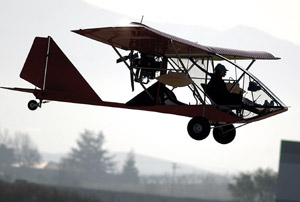
Man’s desire to fly began with the birth of civilization. It
apexed with the Wright Brothers and has continued to evolve
exponentially due to modern technology.
Over the past 30 years, a more elementary type of aircraft, the
Ultralight, has gained in popularity with expert and novice
aviation enthusiasts everywhere.
Man’s desire to fly began with the birth of civilization. It apexed with the Wright Brothers and has continued to evolve exponentially due to modern technology.
Over the past 30 years, a more elementary type of aircraft, the Ultralight, has gained in popularity with expert and novice aviation enthusiasts everywhere.
Aesthetically, the planes resemble the Wright Brothers’ prototype, with a single seat attached to a lightweight frame and powered by a small motor, said Allen Ritter, manager of the Hollister Municipal Airport.
“Some people feel like a bird,” Ritter said. “You’re kind of sitting out in the open on them.”
Their popularity stemmed from being an affordable, transportable and easily constructed method of flight.
People can purchase kits with all the necessary components and build the airplane themselves, Ritter said.
The planes, which don’t require a pilot’s license or any kind of official certification to operate, are considered experimental by the Federal Aviation Administration (FAA) because anything not built by a manufacturer is considered as such, Ritter said.
The lack of regulations makes them as safe as the people piloting them, he said.
“There’s a lot of risks with any (aircraft),” Ritter said.
While there aren’t any regulations placed on the pilots, the percentage of people who attempt to fly one without any education or guidance is low, he said.
“Not too many people have that kind of a death wish that they’d go up in something and crash it,” he said. “After they go to the trouble of building it they aren’t going to just go out and jump in it without some training.”
The FAA considers Ultralights to be a craft that weighs less than 254 pounds, has no more than five gallons of fuel and flies less than 60 mph, according to FAA regulations.
Exceptions are made only for crafts used for training purposes, which are two-seaters and cannot exceed more than 500 pounds or 10 gallons of fuel.
Do-it-yourself kits can be bought at airplane supply stores or over the Internet for as little as $3,000, and can be built in an average of 350 to 450 hours, said Hollister resident and Ultralight builder Tim Floyd.
“Seventy percent of people who actually start the kits don’t finish,” Floyd said. “That’s only 30 percent of people that do complete an aircraft, and the Internet’s full of incomplete (planes to buy).”
Floyd, an unlicensed pilot who’s been flying and building Ultralights since the early 1970s, concedes there are significant risks, which is why it’s important to take the proper safety precautions.
“It pays to be safe,” he said. “That’s why I’m still here today. You have to be humble all the time to it. You have to respect it and inspect it.”
Although he isn’t a certified pilot, he grew up building, designing and working with planes, which gave him the hands-on experience he needs to feel confident in his abilities, he said.
“It’s exciting, it’s fun, but you know the risks when you do it,” he said. “You fly over an area that you don’t mind landing on, you fly high enough where you don’t mind gliding to a certain area to where you’re safe.”
Individuals who don’t abide by these rules cause problems not only in regard to their own safety, but for the entire community, said retired pilot and Hollister resident Daniel Bourbon.
Bourbon is a lifelong aviation enthusiast. Since he became disabled and lost his ability to fly, Bourbon and his family frequent the airport and keep a daily watch on the planes that fly above their home near the airport.
With 98 percent of aircraft accidents and fatalities due to pilot error, allowing an unlicensed individual who may or may not have extensive knowledge of planes pilot a craft around residential areas increases the chance for complications, he said.
“If (Ultralights) are flown responsibly according to rules and regulations, it’s one of the safest things in the world,” Bourbon said. “It can be a fun thing and you can go home and see your wife and family and not harm anybody else – if you’re qualified and if you follow the safety rules. But half these people don’t know what the safety rules are… they don’t have a clue.”
Bourbon has seen many an Ultralight “buzz” (fly below legal limits) his home, coming within 100 feet of the top of his roof. The legal limit of 1,000 feet up is there for a reason – most importantly, it makes it that much harder for a pilot to accidentally fly their plane into a person’s living room, he said.
“That’s not being a responsible pilot,” he said. “Those are the people who widow makers are made of. Flying is real safe, but if people want to do foolish things there’s places to go to do it, but not over residential areas.”
Because Hollister’s airport is considered a UNICOM, which means it doesn’t have a tower, radar or man-station, there’s no one to regulate how low the pilots are flying. The pilots are on their word of honor that they will fly correctly, Bourbon said.
“Here at Hollister we have a great airport, but there’s nothing they can do about (pilot irresponsibility). There’s a lot of UNICOM units around the entire United States… and the community needs to get involved,” he said. “If you see someone buzzing a house, call the manager and identify (the plane).”
Even the most experienced pilots can have accidents in an Ultralight, which is why it’s important to respect the regulations in place concerning airspace and other basic safety rules, Bourbon said.
While he wouldn’t endorse an Ultralight, he admits that the thrill of cruising through the air in one is an exhilaration anyone who wants to experience should – as long as they do it in a safe way.
“If someone wants to go play, go play, but they should have something to say you’re qualified to be in the air, and you’re qualified to put it down and correct anything that happens,” he said. “Some sort of regulations belong there, but there isn’t. There just isn’t.”
Placing regulations on Ultralights is too difficult for the FAA because of the multitude of variables that come with them, Floyd said.
A plan to raise the weight limit is currently being worked on by the FAA, which would make them safer, but other than that it’s a recreation where the responsibility lies within the pilot, not federal laws, he said.
But whether it’s federally regulated restrictions or personal ones, an old flying saying sums it up, Bourbon said.
“There are old pilots, and there are bold pilots,” he said. “But there are no old bold pilots.”









